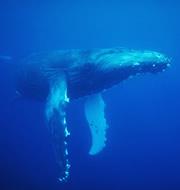 It's a mystery why large animals such as whales aren't ridden with tumours.
It's a mystery why large animals such as whales aren't ridden with tumours.Cancer may be more common but less lethal in large animals, say researchers modelling cancer formation. They suggest that tumours in large animals may spawn even more aggressive tumours that stunt their parents' growth.
Larger animals tend to have more cells and longer lives than small animals. This should make them more likely to get cancer, because having a large number of cells increases the chances of one of them turning malignant, and age is positively correlated with cancer risk.
"Why the chances of getting malignant cancer do not sky-rocket with size is a perplexing question. If size really increased cancer risk than baby whales would die of cancer within days of birth," says Armand Leroi, an evolutionary developmental biologist at Imperial College London, UK.
Biologist John Nagy of Arizona State University in Tempe and his colleagues hypothesized that natural selection will favour the most aggressive cells in a tumour. These grow rapidly, at the cost of secreting chemicals that encourage blood-vessel growth and supply tumours with nutrients.
The authors suggest that these aggressive cells grow on the parent tumour, creating a hypertumour that damages or destroys the parent by sabotaging its nutrient supply. In larger organisms, tumours need to grow very large to become lethal, giving hypertumours more time to evolve.
Computing cancer
“Why the chances of getting malignant cancer do not sky-rocket with size is a perplexing question.”
Armand Leroi
Imperial College London
To test their idea, Nagy and his colleagues used a computer simulation that started with a single randomly located tumour with a nutrient supply. The tumour was challenged by mutant strains that could alter its growth in realistic ways but were not specifically designed to evolve hypertumours.
The team simulated tumour growth and vascularization in six animals, ranging from rat-sized American pikas to humans to blue whales. They ran the simulation 1,000 times for each species.
In most of the simulations, hypertumours evolved and hampered the parent tumour's growth. Larger animals had more hypertumours, and lower rates of fatal cancers. The simulation predicted that for a large animal's tumour to be deadly it would have to grow very quickly and be highly vascularized.
"The idea of the hypertumour is ingenious because it applies darwinian selection amongst cancer cells as mechanism for explaining what we seem to observe in this size paradox," comments Leroi.
Not everyone agrees. "In my opinion, the authors oversimplify the complexity of cancer. They assume an equivalent carcinogenic risk among mammalian cells and this is a false assumption," says Daniel Martineau, a veterinary pathologist at the University of Montreal in Canada.
ADVERTISEMENT
Rodent cells are much easier to transform into cancer cells than human cells, says Martineau. This is partly because they express telomerase, an enzyme that repairs chromosomes. Human cells do not normally express telomerase, which limits their lifespan and could be protective against cancer.
"We know our simulation doesn't prove anything, but it does set up testable predictions, the most important of which is that lethal tumours in large animals have to be highly vascularized," says Nagy. An analysis of whale tumours is a logical next step; if they are found to be vascularized it would give Nagy's hypothesis a boost.
Visit our bigbeastscancersselfdef.html">newsblog to read and post comments about this story.
Imperial College London
